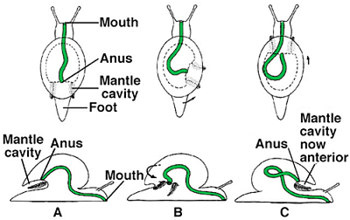Nutrition and Digestion:
Almost all feeding modes are present in the Phylum Gastropoda which has resulted in extremely diverse morphology and physiology. Present feeding modes seen in Gastropods today include microphagus browsers, herbivores, carnivores, omnivores, scavengers, deposit feeders, suspension feeders and parasites (Ruppert, Fox & Barnes, 2004). Common features of a Gastropod gut consist of a mouth, buccal cavity, oesophagus, stomach, intestine, rectum and anus.
Feeding mechanisms of the Trochidae result in large quantities of mineral material and organic material present in the gut. Such a diet requires a gut capable of separating between the two and processing them accordingly. A.Constricta may retain many of the features of a generalised gut (Ruppert,Fox & Barnes, 2004).
Torsion:
Gastropoda are characterised by a unique asymmetry cause by a rotation of the visceral mass and shell, known as Torsion (Ghiselin,1966). Thus Gastropods display the same arrangement as other Molluscs during early development. However eventually developmental processes take over and the 1800 counter clockwise twisting of the visceral mass, shell, mantle and mantle cavity in respect to the foot and head known as Torsion takes place.
Prior to torsion occurring the mantle cavity and organs (gills, nephridiopores, hypobranchial glands, osphradia and anus) are located posteriorly, once torsion is completed mantle cavity and organs are anterior. Currently all Gastropods are torted or have had ancestors that were torted,with torsion signaled the origin of gastropods (second-largest class in animal Kingdom) from monoplacophorans (Ruppert,Fox & Barnes, 2004).
 Figure 1: Displays the process of Torsion in Gastropods (sourced from Encyclopedia of Life)
Figure 1: Displays the process of Torsion in Gastropods (sourced from Encyclopedia of Life)
|